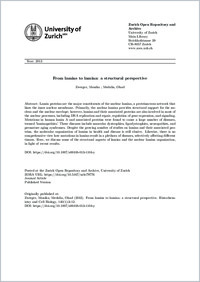From lamins to lamina: a structural perspective.
- 2013-06-08
Published in:
- Histochemistry and cell biology. - 2013
English
Lamin proteins are the major constituents of the nuclear lamina, a proteinaceous network that lines the inner nuclear membrane. Primarily, the nuclear lamina provides structural support for the nucleus and the nuclear envelope; however, lamins and their associated proteins are also involved in most of the nuclear processes, including DNA replication and repair, regulation of gene expression, and signaling. Mutations in human lamin A and associated proteins were found to cause a large number of diseases, termed 'laminopathies.' These diseases include muscular dystrophies, lipodystrophies, neuropathies, and premature aging syndromes. Despite the growing number of studies on lamins and their associated proteins, the molecular organization of lamins in health and disease is still elusive. Likewise, there is no comprehensive view how mutations in lamins result in a plethora of diseases, selectively affecting different tissues. Here, we discuss some of the structural aspects of lamins and the nuclear lamina organization, in light of recent results.
- Language
-
- English
- Open access status
- green
- Identifiers
-
- DOI 10.1007/s00418-013-1104-y
- PMID 23744527
- Persistent URL
- https://folia.unifr.ch/global/documents/141633
Statistics
Document views: 8
File downloads:
- fulltext.pdf: 0
